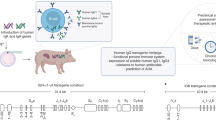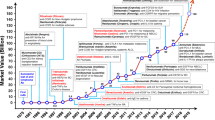Abstract
In 2006, panitumumab, the first fully human antibody generated from transgenic mice, was approved for clinical use by the US Food and Drug Administration (FDA). Since then, a further seven such antibodies have been approved. In this chapter, we discuss how transgenic mice technologies can provide a powerful platform for creating human therapeutic antibodies.
Access this chapter
Tax calculation will be finalised at checkout
Purchases are for personal use only
Similar content being viewed by others
References
Ganesh K, Neuberger MS (2011) The relationship between hypothesis and experiment in unveiling the mechanisms of antibody gene diversification. FASEB J 25:1123–1132
Neuberger MS (2008) Antibody diversification by somatic mutation: from Burnet onwards. Immunol Cell Biol 86:124–132
Cyster JG (2010) Shining a light on germinal center B cells. Cell 143:503–505
Alt FW, Blackwell TK, Yancopoulos GD (1985) Immunoglobulin genes in transgenic mice. Trends Genet 1:231–236
Storb U, Peters A, Klotz E et al (1998) Immunoglobulin transgenes as targets for somatic hypermutation. Int J Dev Biol 42: 977–982
Bruggemann M, Caskey HM, Teale C et al (1989) A repertoire of monoclonal antibodies with human heavy chains from transgenic mice. Proc Natl Acad Sci U S A 86:6709–6713
Taylor LD, Carmack CE, Schramm SR et al (1992) A transgenic mouse that expresses a diversity of human sequence heavy and light chain immunoglobulins. Nucleic Acids Res 20: 6287–6295
Lonberg N, Taylor LD, Harding FA et al (1994) Antigen-specific human antibodies from mice comprising four distinct genetic modifications. Nature 368:856–859
Green LL, Hardy MC, Maynard-Currie CE et al (1994) Antigen-specific human monoclonal antibodies from mice engineered with human Ig heavy and light chain YACs. Nat Genet 7:13–21
Fishwild DM, O’Donnell SL, Bengoechea T et al (1996) High-avidity human IgG kappa monoclonal antibodies from a novel strain of minilocus transgenic mice. Nat Biotechnol 14: 845–851
Mendez MJ, Green LL, Corvalan JR et al (1997) Functional transplant of megabase human immunoglobulin loci recapitulates human antibody response in mice. Nat Genet 15:146–156
Nicholson IC, Zou X, Popov AV et al (1999) Antibody repertoires of four- and five-feature translocus mice carrying human immunoglobulin heavy chain and kappa and lambda light chain yeast artificial chromosomes. J Immunol 163:6898–6906
Tomizuka K, Yoshida H, Uejima H et al (1997) Functional expression and germline transmission of a human chromosome fragment in chimaeric mice. Nat Genet 16:133–143
Tomizuka K, Shinohara T, Yoshida H et al (2000) Double trans-chromosomic mice: maintenance of two individual human chromosome fragments containing Ig heavy and kappa loci and expression of fully human antibodies. Proc Natl Acad Sci U S A 97:722–727
Davis MM (2004) The evolutionary and structural ‘logic’ of antigen receptor diversity. Semin Immunol 16:239–243
Xu JL, Davis MM (2000) Diversity in the CDR3 region of V(H) is sufficient for most antibody specificities. Immunity 13:37–45
Scott CT (2007) Mice with a human touch. Nat Biotechnol 25:1075–1077
Khamlichi AA, Pinaud E, Decourt C et al (2000) The 3′ IgH regulatory region: a complex structure in a search for a function. Adv Immunol 75:317–345
Staudt LM, Lenardo MJ (1991) Immunoglobulin gene transcription. Annu Rev Immunol 9:373–398
Shaw AC, Mitchell RN, Weaver YK et al (1990) Mutations of immunoglobulin transmembrane and cytoplasmic domains: effects on intracellular signaling and antigen presentation. Cell 63: 381–392
Blum JH, Stevens TL, DeFranco AL (1993) Role of the mu immunoglobulin heavy chain transmembrane and cytoplasmic domains in B cell antigen receptor expression and signal transduction. J Biol Chem 268:27236–27245
DeFranco AL, Richards JD, Blum JH et al (1995) Signal transduction by the B-cell antigen receptor. Ann N Y Acad Sci 766:195–201
Zou YR, Muller W, Gu H et al (1994) Cre-loxP-mediated gene replacement: a mouse strain producing humanized antibodies. Curr Biol 4:1099–1103
Valenzuela DM, Murphy AJ, Frendewey D et al (2003) High-throughput engineering of the mouse genome coupled with high-resolution expression analysis. Nat Biotechnol 21: 652–659
Nelson AL, Dhimolea E, Reichert JM (2010) Development trends for human monoclonal antibody therapeutics. Nat Rev Drug Discov 9:767–774
Bradbury AR, Sidhu S, Dubel S et al (2011) Beyond natural antibodies: the power of in vitro display technologies. Nat Biotechnol 29: 245–254
Ponsel D, Neugebauer J, Ladetzki-Baehs K et al (2011) High affinity, developability and functional size: the holy grail of combinatorial antibody library generation. Molecules 16: 3675–3700
Prusiner SB, Groth D, Serban A et al (1993) Ablation of the prion protein (PrP) gene in mice prevents scrapie and facilitates production of anti-PrP antibodies. Proc Natl Acad Sci U S A 90:10608–10612
Williamson RA, Peretz D, Smorodinsky N et al (1996) Circumventing tolerance to generate autologous monoclonal antibodies to the prion protein. Proc Natl Acad Sci U S A 93: 7279–7282
Coffman RL, Sher A, Seder RA (2010) Vaccine adjuvants: putting innate immunity to work. Immunity 33:492–503
Verthelyi D, Wang V (2010) Trace levels of innate immune response modulating impurities (IIRMIs) synergize to break tolerance to therapeutic proteins. PLoS One 5:e15252
Roberts RW, Szostak JW (1997) RNA-peptide fusions for the in vitro selection of peptides and proteins. Proc Natl Acad Sci U S A 94: 12297–12302
Lonberg N (2008) Human monoclonal antibodies from transgenic mice. Handb Exp Pharmacol 181:69–97
Pavri R, Nussenzweig MC (2011) AID targeting in antibody diversity. Adv Immunol 110: 1–26
Rada C, Ehrenstein MR, Neuberger MS et al (1998) Hot spot focusing of somatic hypermutation in MSH2-deficient mice suggests two stages of mutational targeting. Immunity 9: 135–141
Ehrenstein MR, Neuberger MS (1999) Deficiency in Msh2 affects the efficiency and local sequence specificity of immunoglobulin class-switch recombination: parallels with somatic hypermutation. EMBO J 18: 3484–3490
Bransteitter R, Pham P, Scharff MD et al (2003) Activation-induced cytidine deaminase deaminates deoxycytidine on single-stranded DNA but requires the action of RNase. Proc Natl Acad Sci U S A 100:4102–4107
Kohli RM, Abrams SR, Gajula KS et al (2009) A portable hot spot recognition loop transfers sequence preferences from APOBEC family members to activation-induced cytidine deaminase. J Biol Chem 284:22898–22904
Wang M, Rada C, Neuberger MS (2010) Altering the spectrum of immunoglobulin V gene somatic hypermutation by modifying the active site of AID. J Exp Med 207:141–153
Bender NK, Heilig CE, Droll B et al (2007) Immunogenicity, efficacy and adverse events of adalimumab in RA patients. Rheumatol Int 27: 269–274
Coenen MJ, Toonen EJ, Scheffer H et al (2007) Pharmacogenetics of anti-TNF treatment in patients with rheumatoid arthritis. Pharmacogenomics 8:761–773
Getts DR, Getts MT, McCarthy DP et al (2010) Have we overestimated the benefit of human(ized) antibodies? MAbs 2:682–694
Shealy D, Cai A, Staquet K et al (2010) Characterization of golimumab, a human monoclonal antibody specific for human tumor necrosis factor alpha. MAbs 2:428–439
Kay J, Rahman MU (2010) Golimumab: a novel human anti-TNF-alpha monoclonal antibody for the treatment of rheumatoid arthritis, ankylosing spondylitis, and psoriatic arthritis. Core Evid 4:159–170
Varriale S, Merlino A, Coscia MR et al (2010) An evolutionary conserved motif is responsible for immunoglobulin heavy chain packing in the B cell membrane. Mol Phylogenet Evol 57: 1238–1244
Acknowledgments
We thank Allan Bradley, Andrew Sandham, and Glenn Friedrich for critical comments, and all other colleagues at Kymab for helpful discussion.
Author information
Authors and Affiliations
Corresponding author
Editor information
Editors and Affiliations
Rights and permissions
Copyright information
© 2012 Springer Science+Business Media, LLC
About this protocol
Cite this protocol
Lee, EC., Owen, M. (2012). The Application of Transgenic Mice for Therapeutic Antibody Discovery. In: Proetzel, G., Ebersbach, H. (eds) Antibody Methods and Protocols. Methods in Molecular Biology, vol 901. Humana Press, Totowa, NJ. https://doi.org/10.1007/978-1-61779-931-0_8
Download citation
DOI: https://doi.org/10.1007/978-1-61779-931-0_8
Published:
Publisher Name: Humana Press, Totowa, NJ
Print ISBN: 978-1-61779-930-3
Online ISBN: 978-1-61779-931-0
eBook Packages: Springer Protocols




